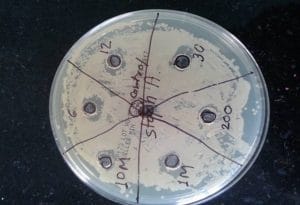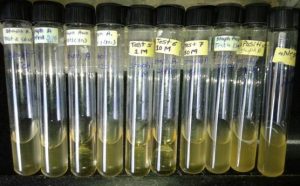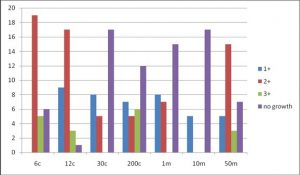Keywords- Potency, Mercurius solubilis, staphylococcus aurius, Turbidity, Repertory, Rubrics, micro-titre plate, antibacterial activity
Abstract –Infectious diseases are very common in our country as well as other developing countries and it accounts about 50% of all diseases. Antimicrobial agents are very helpful in reducing the global burden of infectious diseases. Drug resistance to human pathogenic bacteria has been reported from every part of the world. The aim of this study was to evaluate antibacterial activity of Mercurius solubilis. All potencies were tested in vitro for their activity against staphylococcus aurius isolates. We used Nutrient broth media for bacterial growth and then added Mercurius solubilis and evaluated the percentage of inhibition according to turbidity in all test tubes. All potencies show inhibition of Staph. A., but we found 10M of Mercurius solubilis is more effective for Staph.A. growth inhibition.
INTRODUCTION
For the past 200 years homeopaths have been tasked with explaining the material existence, proof and modus operandi of Homeopathy. There are some areas where we lack or are being criticized. It is a heartfelt need to strengthen our science as per the scientific methods applied universally. This is the fundamental challenge in front of us now, so we must explore the hidden areas, define the flaws and open new horizons for future research. The main aim of research is to look into the matter in a scientific and rational way and the conclusions and benefits must be used for the development of skills, clinical practices and repertories.
Infectious diseases are very common in our country as well as other developing countries and account for about 50% of all diseases. Drug resistance to human pathogenic bacteria has been reported from every part of the world. Therefore, there is a great need to discover and develop new methods for combating microbial infectious diseases, including Staphylococcus Aureus.
Homoeopathy medicines are proven to cure almost any type of illness, so homeopathy can also be tried to kill bacteria. Staphylococcal infections are the most common bacterial infections, especially in hospitals. Some common staphylococcal infections are folliculitis, abscess, wound infection, carbuncle, osteomylitis, pyomyocitis, tonsillitis, pharyngitis, sinusitis, etc.
In Homeopathic Materia Medica and Repertories, Mercurius solubilis is described as a great remedy for suppurative conditions. That’s why I have selected this remedy for my research work to see whether Mercurius solubilis can kill staphylococcus aureus or inhibit the growth.
MATERIALS AND METHOD
Study settings – This study was done in vitro in a microbiology laboratory of Rajiv Gandhi institute of IT and Biotechnology, Bharatividyapeeth Deemed University, Pune- 46.
Media and chemicals – All media was procured from Hi Media Mumbai, India. All the reagents and chemicals used in this work were of AR grade and procured from MERK India.
Homoeopathic drug preparation – The homoeopathic drug Mercurius solubilis in 6CH, 12CH,30 CH, 200 CH, 1M, 10M, 50M, with their liquid dilutions were obtained from Dr, Willmar Schwabe India pvt. Ltd.
Organism – Staphylococcus aureus (NCIM) was used as standard culture to examine antimicrobial activity. Other cultures used in this study are clinical isolates procured from Bharati Hospital, Pune.
Antimicrobial assay- Antimicrobial assay was performed using L-B (Luria Broth) medium or Muellar Hinton agar. For this, the isolates and reference cultures was grown in LB medium to McFarland standard 0.5 for 1.5 approximate cell density of culture was spread individually on LB or Muellar Hinton plate containing base agar overplayed with soft agar.
The well was punctured in soft agar at equidistance using 3-5 mm bore. Drug potencies used for testing are 6CH, 12CH 30CH, 200CH, 1M, 10M, 50M.Only solvent in one well on each plate is ethanol which serves as control.
Plates are incubated at 37 degree C for 24 hours. At the end of incubation period diameter of zones of inhibition was measured. In plate there is zone of inhibition is not measurable because it is not present uniformly or present in zigzag manner.
Exclusion criteria-Following subjects are excluding in study –
Infected material of patient suffering from sexually transmitted disease like HIV, syphilis, gonorrhea, Kaposi sarcoma etc.
Patient having malignancy from any origin.
Inclusion criteria –Samples collected from patients of different age groups including male, female and children.
Outcome assessment – It was reported as sensitive, moderately sensitive, or resistant, referring to the Kirby-Bauer chart reading.
Statistical techniques- Statistical techniques and methods were used wherever required accordingly.
Data analysis- data analysis was done after result of experiment.
DILUTION METHOD –
- We did experiments with 10 drops of medicine, then 20 drops and 30 drops of homeopathic medicine with all potencies.
- Preparation of fresh culture from previously isolated culture of staphylococcus Aureus in nutrient broth.
- Preparation of nutrient broth media for dilution method. 8.5 ml in each test tube.
- Autoclaved all test tubes, distilled water, micro tips and prepared media for 15 minute at 15 PSI (pounds per square inch absolute) at 1200
- After autoclave allowed all test tubes to be cooled and then label the test tube like- positive control, negative control, and alcohol control (90%) and test control 1,2,3,4,5,6,7 etc. according to respective potencies.
- Add 0.5ml freshly prepared culture of staphylococcus aureus in all test tubes except negative control.
- Add 20ml of autoclaved distilled water in positive and negative control.
- Add 20ml of 90% alcohol to alcohol controlled test tube.
- After that we added 20 drops of homeopathic medicine Mercurius solubilis of each potency in respective test control test tubes.
- Then allowed all test tubes for incubation for 24hrs to see the sensitivity of bacteria to either alcohol or medicine and compare it
RESULT AND OBSERVATION
In vitro growth of staphylococcus aureus exhibited singnificant reduction in the presence of Mercurius solubilis 6c 12c 30c 200c 1M 10M 50M compared to negative test and control (90%alcohol). I found the best result was obtained by 10M potency which inhibited the maximum bacterial growth, showing less turbidity as compared to other potencies – observing the absence or presence of visible growth that is turbidity in the test tube +,++,+++.
Effects of Mercurius solubilis on Staphylococcus Aurius
- Finally the graph shows Mercurius solubilis 10M and 30c inhibited the maximum number of growths of staphylococcus aureus.
- Mercurius solubilis 12c having minimum growth inhibition.
DISCUSSION
Nowadays, resistance of bacteria to the antibiotics is a major health problem all over world. It is necessary to discover new medicines which are able to combat resistant bacteria. We know that the homeopathic system of medicine is able to treat those patients having symptoms of infection with drug resistant micro-organisms. In my study, I investigated the action of the homeopathic medicine Mercurius solubilis in different potencies on thirty culture’s of Staphylococcus aureus, The result was indicated by growth inhibition in the culture which is incubated with homeopathic medicine for twenty four hours. We determined the growth of the bacteria by the level of turbidity. In all thirty samples and seven potencies, the best results were found with Mercurius solubilis 30c and 10M potency which covers 16 samples in which the growth of staphylococcus Aureus is inhibited or shows less turbidity, compared to negative test and control test with 90 % alcohol.
CONCLUSION
Homeopathic medicines are used in infectious conditions not in the manner of antibiotics. They don’t directly kill the bacteria but rather inhibit the growth of the bacteria. In the homeopathic system of medicine, we give a medicine to the patient which is able to produce symptoms similar to those produced by a bacterial infection. The remedy works by stimulating the defense mechanism of host, which then kills the bacteria.
For more authenticity the experiment should be done on micro titre plate to see the number of bacterial growths.
ACKNOWLEDGEMENT
Prof. Dr. Arun B. Jadhav, Principal of Bharatividyapeeth Homeopathic Medical College Pune and Dr. Rama Bhadekar (PhD Microbiology) head of department of microbiology, of Rajiv Gandhi institute of IT and Biotechnology, Bharatividyapeeth Deemed University, Pune- 46. are thankfully acknowledged for supporting this work in their department.







Research work is to good and good thought by author in this paper .nice work and go ahead
Nice research work
A good effort. but I think in wrong direction. It is alright for student of Allopathy .
Is Homeopathy changing its principles day by day ?. Are homeopathic medicines acting on patient or microorganisms ? Does homeopathy confirm that disease is caused by Microorganisms and not by diminishing the live force of patient ?.
DEAR DR,
YOUR EXPERIMENT IS COMMENDABLE AND PRAISEWORTHY
YOUR EXPERIMENT BASED ON MOST SCIENTIFIC FUNDAMENTALS PROVES THAT A DRUG POTENTIATED ON HOMEOPATHIC PRINCIPLES IS EQUALLY POWERFUL TO ATTACK AND OVERCOME ON BACTERIA WHICH GIVE RISE TO CERTAIN AWE FULL AND NOTABLE SYMPTOMS IN THE BODY OF THE PATIENT, WHICH MATCH THAT DRUG . THIS CAN SHUT THE MOUTH OF ALLOPATHS WHO SAY THAT HOMEOPATHIC MEDICINES ARE PLACEBO ONLY
THANKS
wonderful researched Analysis, fantastic explanation. very useful researched input to the practitioners. now anyone can administer Merc Sol with highest confidence that too 30 c & 10 m potency.
i request Dr Sapna j to conduct research on Echinacea to use it as Homeopathic Antibiotic, because i read one Naturopathy Research Institute of USA has published that Echinacea is very powerful Natural Herb to use as Antibiotic for any type of infection. But they have not done research by Homeopathic angle & potency. please take up it to popularise Homeopathy worldwide.
Nice research work